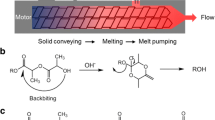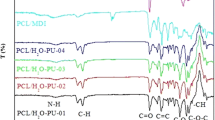Abstract
Biodegradability and biocompatibility of poly(ε-caprolactone) (PCL) are the prime properties which advanced the use of this polymer in fields of tissue engineering and biomedicals. Being an aliphatic polyester, PCL is prone to undergo trans-esterification which is one of the mechanisms reported for its degradation besides being used in making its copolymers. Trans-esterification occurs both, inter- and intra-molecularly and in this work we report that the mechanism of trans-esterification depends on the molecular weight of the polymer when it is subjected to 160 °C for time up to 24 h. For low molecular weight PCL (Mp = 10,000 g/mol) inter-molecular trans-esterification is the predominant mechanism while for the high molecular weight PCL (Mp = 80,000 g/mol) it is intra-molecular. A mid molecular weight PCL (Mp = 43,000 g/mol) showed presence of both, inter- as well as intra-molecular trans-esterification, when heated at 160 °C for 24 h. A decrease in relative crystallinity for all the samples showed reduction in crystalline component of the polymer confirming occurrence of trans-esterification at chosen conditions. An increase in tensile strength and modulus is observed after treatment at 160 °C for 24 h due to formation of more entangled network of polymer chains as a result of trans-esterification reactions.








Similar content being viewed by others
References
Woodruff MA, Hutmacher DW (2010) Prog Polym Sci 35(10):1217
Labet M, Thielemans W (2009) Chem Soc Rev 38(12):3484
Albertsson A-C, Srivastava RK (2008) Adv Drug Deliv Rev 60(9):1077
Hakkarainen M (2002) Adv Polym Sci 157:113
Hakkarainen M, Albertsson A-C (2008) Adv Polym Sci 211:85
Tokiwa Y, Ando T, Suzuki T (1976) J Ferment Technol 54(8):603
Fields RD, Rodriguez F, Finn RK (1974) J Appl Polym Sci 18(12):3571
Benedict CV, Cameron JA, Huang SJ (1983) J Appl Polym Sci 28(1):335
Murphy CA, Cameron JA, Huang SJ, Vinopal RT (1996) Appl Environ Microbiol 62(2):456
Oda Y, Asari H, Urakami T, Tonomura K (1995) J Ferment Bioeng 80(3):265
Eldsater C, Erlandsson B, Renstad R, Albertsson A-C, Karlsson S (1999) Polymer 41(4):1297
Lefebvre F, David C, Vander WC (1994) Polym Degrad Stab 45(3):347
Ohtaki A, Akakura N, Nakasaki K (1998) Polym Degrad Stab 62(2):279
Toncheva V, Van Den BA, Schacht E, Mergaert J, Swings J (1996) J Environ Polym Degrad 4(2):71
Gan Z, Liang Q, Zhang J, Jing X (1997) Polym Degrad Stab 56(2):209
Iwabuchi S, Jaacks V, Kern W (1976) Makromol Chem 177(9):2675
Ouhadi T, Stevens C, Teyssie P (1976) J Appl Polym Sci 20(11):2963
Garozzo D, Giuffrida M, Montaudo G (1986) Macromolecules 19(6):1643
Plage B, Schulten HR (1990) Macromolecules 23(10):2642
Day M, Cooney JD, Shaw K, Watts J (1998) J Therm Anal Calorim 52(2):261
Persenaire O, Alexandre M, Degee P, Dubois P (2001) Biomacromolecules 2(1):288
Aoyagi Y, Yamashita K, Doi Y (2002) Polym Degrad Stab 76(1):53
Sivalingam G, Madras G (2003) Polym Degrad Stab 80(1):11
Xie W, Gan Z (2009) Polym Degrad Stab 94(7):1040
Unger M, Vogel C, Siesler HW (2010) Appl Spectrosc 64(7):805
Kricheldorf HR, Kreiser I (1987) J Macromol Sci Chem A24(11):1345
Lipik VT, Widjaja LK, Liow SS, Abadie MJM, Venkatraman SS (2010) Polym Degrad Stab 95(12):2596
Srivastava RK, Albertsson A-C (2007) Macromolecules 40(13):4464
Ma D, Xiang X, Luo X, Nishi T (1997) Polymer 38(5):1131
Yang IK, Hong CY, Pan PH (2003) Int Polym Process 18(3):273
Chen J-L, Huang H-M, Li M-S, Chang F-C (1999) J Appl Polym Sci 71(1):75
Shieh Y-T, Lin Y-T (2007) Eur Polym J 43(5):1847
Pal J, Kankariya N, Sanwaria S, Nandan B, Srivastava RK (2013) Mater Sci Eng C Mater Biol Appl 33(7):4213
Crescenzi V, Manzini G, Calzolari G, Borri C (1972) Eur Polym J 8(3):449
Acknowledgments
Authors gratefully acknowledge the financial support provided by Indian Institute of Technology Delhi and Department of Science and Technology India to perform this research.
Author information
Authors and Affiliations
Corresponding author
Rights and permissions
About this article
Cite this article
Pal, J., Sanwaria, S., Choudhary, A. et al. Thermally Initiated Trans-esterification in Poly(ε-caprolactone) and Its Dependence on Molecular Weight. J Polym Environ 22, 479–487 (2014). https://doi.org/10.1007/s10924-014-0669-4
Published:
Issue Date:
DOI: https://doi.org/10.1007/s10924-014-0669-4




